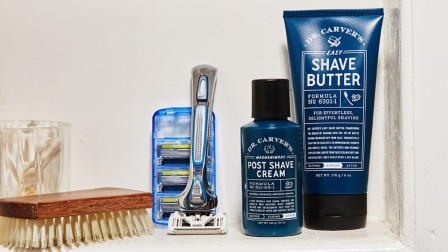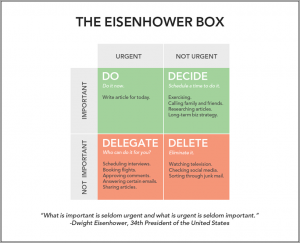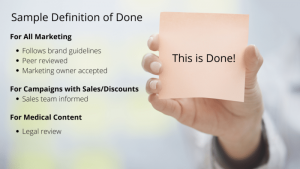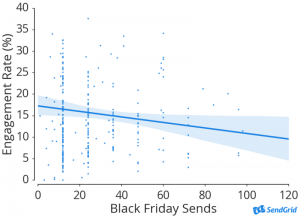As the company’s first marketing employee, Adam Weber now serves as Dollar Shave Club’s CMO, leading the brand’s video marketing strategy.

In 2012, Dollar Shave Club launched its brand on YouTube with the famous “Our Blades Are F****** Great!” video, bringing in 12,000 customers for the subscription razor service within the first two days.
Since then, Dollar Shave Club has continued its commitment to video, keeping a relatable style and tone across its wide breadth of video marketing efforts.
“We do use irreverence and humor as a really critical mechanism to deliver that relatability,” says Dollar Shave Club CMO Adam Weber, “That’s what we really aim to do from a tonality standpoint that I think is different than how brands have talked to guys in the past.”
Weber has been with the brand since its start, joining the Dollar Shave Club as its first marketing employee in 2012. Now, as the brand’s CMO, Weber leads a team of just over 25 people split among five separate groups that cover brand management, PR, consumer insights, media and customer acquisition and CRM.
When asked about the role video plays the company’s overall marketing strategy, Weber defines it as the heartbeat of Dollar Shave Club’s brand.
“It’s what brought this brand into the world. It’s what launched this brand. It helped get awareness by really spreading the word on what made us unique versus our competition in the early days.”
Today, Weber shares how Dollar Shave Club has made video a cornerstone of the brand’s marketing strategy, and how he sees video marketing evolving in the coming years.

Adam Weber
CMO @ Dollar Shave Club
Takeaways:
1. Design for the channel. Context matters. Don’t copy and paste your content.
2. Approach production with agility. Don’t be afraid to improvise.
3. Tell a story, don’t just sell. Ads are by nature intrusive — videos should reward the consumer for giving you a moment of their time.
Amy Gesenhues: To start, tell me how your video efforts are managed. Do you have a specific team that oversees all of Dollar Shave Club’s video marketing, or is it a shared responsibility?
Adam Weber: I would say the way that our video strategy comes to life involves three teams. The brand marketing team really works on how to get the messaging right.
We actually have an internal advertising agency. We don’t outsource any of our brand creativity, we keep it in-house. That team works very closely with the brand team on the messaging strategy and how to bring that to life in a compelling way and how to tell the story the right way.
Of course, then they work with the media and customer acquisition team, who really is the team that helps distribute that content, get it out there in front of the right consumer and at the right rate from a return on investment standpoint. Really, our video strategy resides within those three groups.
AG: How do you define your brand’s video marketing strategy?
AW: For me, it isn’t as much about what channels it goes into. What video offers — and nothing else does in the creative landscape — is an amazing platform for storytelling.
More than any other channel, you can really reach a guy, or really, a consumer in general, and establish a much deeper emotional connection with video than you can in other creative venues. That’s because we can tell stories well. We can find a resonant idea, we can deliver it in a relatable voice and connect one-to-one.
Video has been like that for Dollar Shave Club from the beginning. What we’ve really focused in on since our launch video has been all about finding which new stories to tell, to what consumers, and then finding the right distribution platforms to tell them.
Dollar Shave Club’s launch video
We take our video storytelling to the obvious places. We do a lot of investment in television, which is a great place to tell a narrative with video.
I think in the long term, as you get more into the digital places, the social outlets like YouTube, Facebook, Snapchat, Twitter — those types of venues are great venues for telling stories via video. Those have become an increasingly larger part of our game plan. They offer a lot of unique capabilities that something like television doesn’t offer.
What we’ve been focusing on is designing for those channels first and making sure that we have great content in those spaces to make our video strategy more broadly appealing.
AG: Dollar Shave Club’s videos have a distinct tone and style. Can you share more about how your brand developed such a specific voice in its video marketing efforts?
AW: What we do that I think, that wasn’t available, particularly in the grooming spaces, we talked to guys in a relatable voice.
For so long, for a lot of the spaces talking to men, it was like you had to chose — you were either going to be very highbrow, slightly unapproachable, extremely aspirational, but really, largely unattainable as a brand — or you were going to approach men as Neanderthals. I think those tones, as our brand I think proves, don’t really work.
The way to reach guys nowadays, and to have that authentic feel, is to be relatable, allow guys to put themselves in your shoes as a brand, as opposed to talking at them or talking above them.
AG: As Dollar Shave Club’s original marketing employee, can you tell me more about the evolution of your brand’s video marketing efforts?
AW: Our original video started on YouTube, because that was a great place for encouraging share-building. That’s what the original video aimed to do.
Our next move though was really about mass distribution. We took that video, we found a compelling way to get it into a TV format that made sense, and we took it to that mass audience and went to television.
Really, since then, what we have been focusing on as we continue to invest in telling that story is really trying to get more focused on specific channels and working backwards.
AG: What is the aim of your latest campaign?
AW: Our newest campaign is called “What the FAQ?” It’s a video series that we’ve basically used to address a lot of barriers that we were hearing our customers talk about as to why they didn’t want to sign up.
We’re, as a brand, really trying to get men to change their behavior. They’ve become accustomed to buying things in the stores, touching them, picking them up. They’ve been accustomed to buying them one-off, not on subscription. Our model needed a little bit more explanation, and our consumers were telling us that.
This new video campaign aims to really go after to those barriers with “What the FAQ?” which is frequently asked questions. What we did there differently was we went with the digital landscape in mind. We knew where this was going to live uniquely, and we designed for it.
An example of that, I think two examples, is on YouTube. When you run pre-roll, two things that a channel like YouTube allows you to do that are different than television: First, it’s hyper-targeted. We can identify which guys in that landscape probably are highly aware of Dollar Shave Club, are about to sign up but haven’t yet, which allows the strategy to work really uniquely.
Second, like when we talk about designing the video content for the channel, YouTube is all about the first five seconds, right? It’s on cost-per-view model. Consumers have the ability to opt out or skip. You really have to do a lot of work. Forget how long it lasts after that, the most important seconds are the first five.
This campaign, for example, really aimed to get an eye-catching, stop-you-in-your-tracks piece of creative drama right away in the first couple of seconds. Then we also use a story line of “What the FAQ?” which was compelling and created curiosity.
If you hear that title card showing up in the first five seconds, you want to hear more. That’s really the difference between designing for television and designing for YouTube. We really focus on the first five seconds to get past that “Skip Ad” button.
The same could be said when we look at other channels. A lot of social-based channels, like Facebook, are not consumed with audio. There’s a lot of work that needs to be done to make the content that we create from the video standpoint still interesting, but interesting in a way that can be done without having to rely on audio as a mechanism for telling the story.
I think those are two examples in this more recent campaign where we adjusted our video strategy to be about the channel first, then we customized what message we wanted to tell, and then production to make sure we were delivering what were best practices for the channel.
AG: What metrics do you use when gauging the success of a video marketing campaign?
AW: When you do things in digital, you can track them back to your website. We look at last clicks and what volume of traffic of consumers are coming to our site to buy.
There’s also some upstream metrics that we look at and that we’ll evaluate ROI on. We’ll look at things like video completion rate, which is a way of really measuring how effective your ad was at reaching the consumer and how engaged they were with it.
We’ll look at metrics that are a little bit more brand-centric around likelihood to buy in the future, brand familiarity and aspects that we’re trying to invest in for the long term — which predict future customers, but may not result in immediate customers like a lot of digital landscapes or digital ads really try to force you into.
AG: Do you guys use any specific social listening or analytic tools beyond what the platforms offer?
AW: I actually think that the platforms have really smartly invested in making their platform analytics intelligent.
I have to give kudos to Facebook and YouTube. We’ve tried a bunch of martech — I think the platforms are doing a really good job of understanding what their brands need and making sure that they provide analytics that deliver against that.
We’ve really gotten, and built, strong relationships with the platforms themselves and use those as the background for our analytics and measurement systems. I would say that’s where we’ve been focused more recently.
AG: Can you share any specifics around how platforms like YouTube or Facebook are working with you as a brand?
AW: No specifics — obviously, there’s some stuff that we want to keep between us and our partners. I would say that, I think, those partners — and particularly Facebook — do a really good job of not just being a vendor. They’re not just a media player for us. We do joint business planning with them. We do it monthly, but we meet with these guys weekly, talk to them daily.
It’s such a big piece of our brand and our growth strategy. It’s something that, if you are willing to invest in, not from a money standpoint, but also from a human standpoint, they will equally invest back in you.
We’ve really treated them as strategic partners the same way that in old-school models, that you’d treat your advertising agency as a strategic partner. We really look at those guys as sitting on the bench with us, trying to achieve the same goals as us.
When you approach it that way, they want to bring new tools to you before the rest of the marketplace does. They want to try things that they’re thinking about out on you and see if it’s an effective tool that they can bring to their broader platform of advertisers. That’s the benefit of it — we are usually on the forefront of what’s next inside of those platforms, whether it’s an ad product or a measurement system.
AG: What has been one of your most successful campaigns as far as engagement?
AW: Recently, we did some work around Father’s Day on Facebook, around quick-hit stop-motion ads. It’s not your traditional beginning, climax, end, start, stop, finish type of video.
It was built for short-amount-of-time consumption, quick hit in the Facebook feed, over-the-top view that really told a great story about why our gift was a better gift for Father’s Day than the alternative.
It’s not your traditional way of what most people would say is great video advertising, but what it did do was successfully get a Facebook audience to engage in a different way with our brand, and it did it with agility.
We were able to iterate on it. We were able to do it with low production investments — really get almost the same level of engagement as those bigger, longer stories get, but to do it with much more channel-centric insights built into it.
I really think that’s the future. Mobile and social have fundamentally changed the way people view videos. If you don’t build back from that nowadays, you’re missing out. If you just try to cut and paste your TV strategy into those channels, you’re not going to get engagement. That’s one that I’m particularly proud of that we did recently.
AG: You mentioned the Father’s Day campaign resulted in fans engaging differently with your videos — how so?
AW: Obviously, when you do a static ad in Facebook, you’re going to get a much different type of engagement. You’re lucky if your ad is good enough, you’ll get likes and comments, or you’ll get a click-through on a link to the site. Those are great engagements, we obviously value those engagements.
What this allowed us to do was actually get people to spend some time absorbing what the brand is trying to communicate versus taking an immediate action. The different type of engagement was completion rate.
Instead of it being a 30-second ad that no one finishes because it’s too long, or I can’t hear the audio, or I lost interest inside of my feed, it was seven to 15 seconds, and it was done, and they watched it more than once because it was so compelling. It’s a very different type of brand engagement.
AG: As your brand’s first marketing employee, what have been your biggest lessons around video production?
AW: I think the biggest one is you don’t just have one shot, right? You have to take the pressure off of yourself to get it right on one try. You need to build an ecosystem for video production that allows you to be nimble and agile and adapt.
We, as a brand, actually did only have one shot at one point in time — that was our original launch video. We did get it right, and that was great, it was a home run. I think after that, for us, it was about hitting singles and doubles. We did hit a few home runs after that — it’s not like we can’t; but I actually think it’s about hitting more frequent singles and doubles in this world than it is about hitting an occasional home run.
You have to be willing to try. You have to be willing to fail. You have to be willing to spend some money sometimes that won’t pay out in the immediacy, but may pay out in the long term. I think that’s probably the biggest lesson.
It’s about the willingness to learn and fail, but ultimately to try a bunch of different things to get it right. From a production standpoint, you need to build your system around that, not around hitting one-off home runs.
AG: How do you see video marketing evolving?
AW: I think most brands go TV first and then adjust accordingly to digital. That’s definitely going to change.
You’ve got to design for context first, and most video consumption isn’t happening on television nowadays. I think that’s the first one. It’s about how they create it, and with what channel in mind from the beginning. To enable that, some things have to change. The production and creative relationships you hold have to evolve. You have to be more agile, cost-effective, iterative with your video creation.
It can’t be this multi-million dollar, four-day shoot in Hollywood, get the biggest, best production companies in the world. That’s a waste of money.
AG: Do you agree that viewers are turning away from the more polished video production and wanting a more “raw” experience when it comes to what they’re watching?
AG: Exactly — that’s the third piece. It’s the best form of agility: It’s live, it’s improvisational. I think that’s where things are heading — lower expectations on video, whatever we use to define as an industry as quality, which I find false in the first place.
It’s about what the message is, and how it’s delivered and what the story is. It’s truly about the creativity behind it, less about the production value. I think live environments — or even one-to-one environments on places like Snapchat — are going to be the future.
Marketing Land – Internet Marketing News, Strategies & Tips
(91)
Report Post








